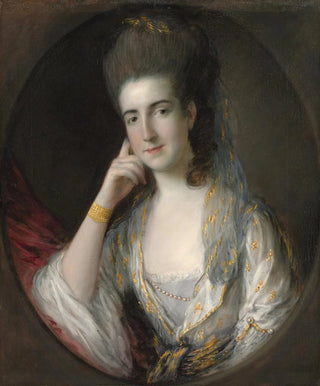Art print | Portrait of Mary Wise - Thomas Gainsborough


View from behind

Frame (optional)
The "Portrait of Mary Wise" by Thomas Gainsborough is an iconic artwork that embodies the elegance and finesse of 18th-century British portraiture. This painting, depicting a young woman with striking beauty, invites viewers to immerse themselves in a universe where grace and delicacy meet. Through this portrait, Gainsborough succeeds in capturing not only the physical appearance of his model but also an essence, a personality that transcends mere visual representation. The piece stands out for its ability to establish a dialogue between the subject and the observer, making Mary Wise come alive and feel accessible, even centuries after its creation.
Style and uniqueness of the artwork
Gainsborough's style is characterized by an exceptional mastery of light and color. In the "Portrait of Mary Wise," the artist uses soft tones and subtle nuances to create an intimate atmosphere. The drapery of Mary’s dress, painted with remarkable fluidity, almost seems to float, adding an almost ethereal dimension to the composition. The brushwork technique, both precise and free, gives the painting a rich texture that draws the eye and invites exploration of the details. Mary’s slightly turned posture and her contemplative gaze evoke psychological depth, allowing the viewer to feel an emotional connection with the subject. Gainsborough, through his unique approach, manages to fuse realism and romanticism, creating a timeless work that continues to inspire awe.
The artist and his influence
Thomas Gainsborough, one of the undisputed masters of portrait and landscape painting, marked his era with his ability to innovate while remaining faithful to the artistic traditions of his time. Born in 1727, he quickly gained notoriety thanks to his talent and vision. Gainsborough skillfully integrated elements of nature into his portraits, which is particularly evident in the "Portrait of Mary Wise," where the natural background enhances the harmony of the whole. His influence is palpable in the evolution of portraiture, inspiring many artists across the centuries. His way of handling light, color, and texture paved the way for later artistic movements, notably

Matte finish

View from behind

Frame (optional)
The "Portrait of Mary Wise" by Thomas Gainsborough is an iconic artwork that embodies the elegance and finesse of 18th-century British portraiture. This painting, depicting a young woman with striking beauty, invites viewers to immerse themselves in a universe where grace and delicacy meet. Through this portrait, Gainsborough succeeds in capturing not only the physical appearance of his model but also an essence, a personality that transcends mere visual representation. The piece stands out for its ability to establish a dialogue between the subject and the observer, making Mary Wise come alive and feel accessible, even centuries after its creation.
Style and uniqueness of the artwork
Gainsborough's style is characterized by an exceptional mastery of light and color. In the "Portrait of Mary Wise," the artist uses soft tones and subtle nuances to create an intimate atmosphere. The drapery of Mary’s dress, painted with remarkable fluidity, almost seems to float, adding an almost ethereal dimension to the composition. The brushwork technique, both precise and free, gives the painting a rich texture that draws the eye and invites exploration of the details. Mary’s slightly turned posture and her contemplative gaze evoke psychological depth, allowing the viewer to feel an emotional connection with the subject. Gainsborough, through his unique approach, manages to fuse realism and romanticism, creating a timeless work that continues to inspire awe.
The artist and his influence
Thomas Gainsborough, one of the undisputed masters of portrait and landscape painting, marked his era with his ability to innovate while remaining faithful to the artistic traditions of his time. Born in 1727, he quickly gained notoriety thanks to his talent and vision. Gainsborough skillfully integrated elements of nature into his portraits, which is particularly evident in the "Portrait of Mary Wise," where the natural background enhances the harmony of the whole. His influence is palpable in the evolution of portraiture, inspiring many artists across the centuries. His way of handling light, color, and texture paved the way for later artistic movements, notably






